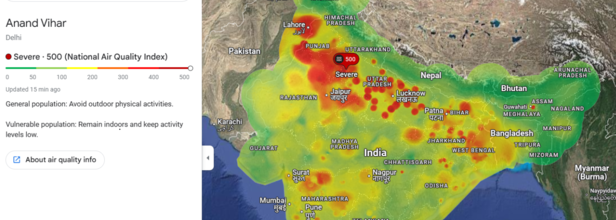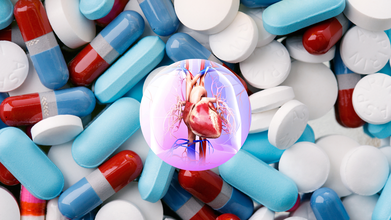- Health Conditions A-Z
- Health & Wellness
- Nutrition
- Fitness
- Health News
- Ayurveda
- Videos
- Medicine A-Z
- Parenting
- Web Stories
Air Pollution Is Also Linked With Obesity And Many Other Diseases

The National Capital Region (NCR) has seen a spike in the Air Quality Index (AQI) post-Diwali. Several places in Delhi recorded AQI in the "very poor" category, while Anand Vihar recorded "severe", and crossed the 500 mark on the AQI meter. Sahibabad in Ghaziabad also recorded "very severe", touching the 500 mark. These AQI levels are reported as of November 5, (Tuesday), 9 am.
Gurugram recorded 484 "severe", Faridabad at 315 "very poor", Hauz Khas at 398 "very poor", Vasant Kunj at 439 "severe", Old Delhi at 312 "very poor", Burari at 451 "severe, parts of Noida (Sector 5) at 291 "poor", and Connaught Place at 369 "very poor".
The Link Between Air Pollution And Obesity
While we all know that air pollution is linked with several respiratory diseases, a new research also suggests that it may be linked to rising obesity rates. As per a 2021 study titled Effect of Air Pollution on Obesity in Children: A systematic Review and Meta-Analysis, there is a connection between air pollution and weight gain through biological behavioral mechanism. The major pollutants causing obesity are nitrous oxides, nitrogen dioxide, ozone, and particulate matter.
These could lead to systematic inflammation and metabolic disturbances, which can lead to weight gain and obesity. The study mentions that fine particulate matter [PM2.5], when it enters our body, it influences the metabolism rates.
The 2021 study also revealed that increase in air pollution, and road traffic noise was also associated with childhood obesity.
Another 2011 study titled The influence of air pollution on cardiovascular and pulmonary function and exercise capacity: Canadian Health Measures Survey (CHMS), found that air pollutants may indirectly impact body weight by raising the risk of chronic conditions like blood pressure, heart diseases or lung diseases. "Exposure to higher concentrations of air pollution was associated with higher resting blood pressure and lower ventilatory function. Ozone was associated with reduced exercise capacity," researchers of the study wrote.
The latest study published in 2024 titled The association between air pollution and obesity: an umbrella review of meta-analyses and systematic reviews, found that air pollution can impact metabolic function by influencing inflammation in fat tissue. It leads to an increase in oxidative stress and alters one's dietary habits.
Women's Health And Pollution
In fact, pollution can also lead to gynaecological issues, said Dr Anuradha Kapur, Principal Director (Obstetrics & Gynaecology) and Head of Unit, Max Smart Super Speciality Hospital, Saket. "Environmental pollutants, such as pesticides and microplastics, can affect reproductive health and hormone regulation, potentially impacting menstrual cycles," she said.
Dr Sonam Simpatwar, Gynaecologist with a diploma in reproductive medicine, practising at Central Railway Hospital, Mumbai further explained how pollutants impact women's health:
Endocrine Disruptors: Chemicals found in pollution, plastics, and pesticides can mimic or interfere with hormones, potentially affecting menstrual cycles.
Climate Change: Rising temperatures, extreme weather events, and changes in water quality can impact food production, nutrition, and overall health, which can indirectly affect menstrual health.
Stress: Environmental stressors, such as pollution and climate change, can lead to increased stress, which is known to influence menstrual cycles.
"It's important to note that these are potential factors, and more research is needed to fully understand their impact on menstrual health," she said.
Five Every Day Drugs That Could Negatively Impact Your Heart, According To Doctor

Credits: Canva
Every medicine has its own set of side effects, and Dr Dmitry Yaranov, a Russia-based cardiologist, who specializes in heart failure, advanced heart failure, heart transplantation, and mechanical circulatory support, says that some everyday drugs can pose hidden risks to the heart. His message is not meant to spark fear but to encourage awareness about medications we often assume are completely harmless.
Below are five categories of common drugs that Dr. Yaranov believes deserve more caution, especially for those with existing heart issues.
NSAIDs - Nonsteroidal Anti-inflammatory Drugs
These are your everyday painkillers, which includes ibuprofen or naproxen. While they are go-to options for headaches, fever, or muscle cramps, Dr Yaranov says that its frequent use could strain the heart.
These drugs reduce inflammation by blocking certain chemical pathways, but they also make the body retain salt and water. This can:
- Raise blood pressure
- Worsen swelling
- Increase the risk of heart failure, particularly in people who already have high blood pressure or heart disease
Dr. Yaranov suggests discussing long-term or frequent NSAID use with a doctor, instead of using them casually.
Chemotherapy Drugs
While these drugs are life-saving, it may have side effects that could weaken the heart muscles. Dr Yaranov explains that drugs like doxorubicin or trastuzumab could also affect how well the heart pumps blood, which can lead to ardiomyopathy or heart failure.
Because of this, many cancer centres now include routine heart monitoring before, during, and after chemotherapy. The goal is to fight cancer without compromising long-term heart health.
Stimulant Medicines For ADHD
Stimulants that contain amphetamines help improve focus and alertness, but Dr. Yaranov warns that they can also:
- Increase heart rate
- Raise blood pressure
- Trigger arrhythmias
Elevate the risk of heart attack in people who have underlying heart issues
He stresses that misuse or unsupervised use is especially dangerous. Even for those who take them as prescribed, regular follow-ups with a doctor are important.
Older Diabetes Medications
Managing diabetes could mean being on medicines for lifelong. Yaranov points out that older drugs like rosiglitazone can increase the risk of heart failure despite effectively lowering blood sugar. Because of these concerns, many doctors now prefer newer diabetes medications that also support cardiovascular health. However, patients should never switch or stop medicines without medical guidance.
Common Cold Medicines
Thanks to allergens and climate change, common cold now stays all around the year, which means you will be taking cold medicines frequently and for a longer stretch. These medicines contain pseudoephedrine that work by narrowing blood vessels to relieve nasal congestion, however, Dr Yaranov says that they can also:
- spike blood pressure
- Disturb normal heart rhythms
- Increase strain on the heart
For individuals with hypertension or heart disease, Dr. Yaranov advises avoiding these drugs or using them only after consulting a healthcare provider.
Dr. Yaranov’s core message is simple: even routine medications have side effects worth understanding. Being informed helps people protect their cardiovascular health, especially if they already have heart risk factors. The goal is not to avoid necessary treatment but to use medicines wisely and stay in regular touch with your doctor.
Note: This article is based purely on the remarks shared by Dr. Dmitry Yaranov. Health and Me does not recommend discontinuing or changing any medication without first consulting your doctor.
TrumpRx Deal For Lowering Popular Weight Loss Drugs Is Not Flawless, People May End Up Paying More, Say Experts

Credits: AP
"Did I do a good job? Do you think Biden could have done this? I don't think so," said President Donald Trump to the reporters assembled at the Oval Office after he made the announcement that he had secured a deal to slash the price of obesity drugs. His website, TrumpRx, will offer the sale of drugs like Wegovy and Zepbound, for only around $250 a month, which is a fraction of their current retail price which is more than $1,000.
While it is a breakthrough, as many private insurances do not cover obesity drugs, and often forces people to pay for these injections out of pocket, experts point out that this system is not entirely flawless.
TrumpRx Is Not Flawless
Drug policy experts say that while the administration has promised drugs at a cheaper rate, some of these discounts have not been approved yet by the Food and Drug Administration. The problem is that the lower prices for people paying out of pocket would only apply to the lowest doses of the drugs, however, the deal does not expand Medicare coverage to people seeking treatment for weight loss alone.
Juliette Cubanski, who is the deputy director of Medicare policy program at KFF, said, and as is reported in NBC News, "It’s a situation where we have more questions than answers. Based on what we didn’t hear, that suggests to me that there’s a lot that the administration itself hasn’t even ironed out as of yet. It just feels a little bit too squishy right now."
Art Caplan, also reported in NBC News, who is the head of the division of medical ethics at NYU Grossman School of Medicine in New York City, said, "It’s just murky as to how this will take shape, how the programs will work. You can’t really tell from what’s going on.”
Are There Unapproved Drugs On The List?
Several drugs and forms of drugs included in the deal are actually not approved by the FDA. These include oral versions of weight loss drugs, and Eli Lilly's new multidose injection pens. In fact, Lawrence Gostin, director of the O'Neill Institute for National and Global Health Law at Georgetown University said that the administration has made premature promises because the lower prices cannot take effect until the products are on the market. "It is reckless to negotiate pricing deals on products which the FDA have not yet approved as safe and effective. The administration is getting way out ahead of its own safety agency.”
The list includes:
- Oral weight loss pills by Wegovy
- Oral weight loss pills by Novo Nordisk
- Multidose version of Zepbound
Prices Are Low, But People May End Up Paying More
While the White House did say that both the pills and injection pens will be available for discounted prices for those who pay out of pocket, policy makers say that they may end up paying more.
The starting doses of weight loss pill will cost $149 per month, and the shots will cost around $350 for a month's supply. The price of the injection is further expected to fall to about $259 within two years. However, when people start with the drugs, they start with the lowest dose that allows the body to get used to the drug, However, over the course of time, the dose increases to be effective for weight loss. For Wegovy, the highest doses are five, for Zepbound, it is six, and the most weight loss has seen with the highest doses.
Officials said the starting dose of GLP-1 pills will cost $149 per month, though they didn’t clarify pricing for higher doses.
For injections, the White House offered only a “weighted average” estimate of $350 a month. Lilly later specified that Zepbound will start at $299 for the lowest dose, rising to $449 for higher ones. Novo Nordisk didn’t confirm dose-based pricing and said it will share updated cost details in the coming weeks.
All of this means patients using TrumpRx could ultimately pay significantly more than the administration’s headline prices, especially since most people don’t remain on the lowest dose for long, Caplan noted.
Davina McCall Reveals Breast Cancer Surgery A Year After Her Brain Tumor Surgery

Credits: Wikimedia Commons
TV presenter Davina McCall revealed that she had breast cancer, almost a year after she had undergone a surgery to remove her brain tumor. In a video that she posted on her Instagram, she revealed that she was "very angry" when she found out the news, however, she is in a "much more positive place" after she has undergone another surgery three weeks ago to remove the tumor from her breast.
How Did She Realize She Had Breast Cancer?
She said that she found a lump a few weeks ago, however, it came and went back, so she continued to do her work. "I found a lump a few weeks ago. It came and went but then I was working on The Masked Singer and Lorraine, the TV show, and Lorraine Kelly had put signs on the backs of all the doors saying 'check your breasts' and every time I went for a wee, I did that," she said.
She continued: "It was still there, and then one morning I saw myself in the mirror and thought 'I'm going to get that looked at'. I had a biopsy. I found out it was indeed breast cancer and I had it taken out in a lumpectomy nearly three weeks ago."
McCall, who is now 58, says that the lump was "very, very small" and was discovered at an early stage. "I am so relieved to have had it removed and to know that it hasn't spread. My lymph nodes were clear, I didn't have any removed, and all I'm going to do now is have five days of radiotherapy in January as kind of an insurance policy," she said.
"It's been a lot. I was very angry when I found out, but I let go of that, and I feel in a much more positive place now. "I think my message is: get checked if you're worried. Check yourself regularly. If you are due a mammogram, then get it done," she said.
Dense Breast And Mammogram
She also revealed that it was only in August that she got her mammogram done, however, she has dense breasts, and so nothing was detected. "I have dense breasts and I had a mammogram in August, and I was postponing the ultrasound; I just couldn't find time to do it. Don't do that. Get the ultrasound."
Difference Between Breast Ultrasound And A Mammogram
Breast Ultrasound: A breast ultrasound uses sound waves that reflect off the breast tissue to create detailed images of the breast. There is no radiation involved.
Mammogram: A mammogram is an X-ray of the breast. A mammogram is an X-ray of the breast. A diagnostic mammogram focuses more closely on the area(s) of concern. We will get more X-ray views of the concerning area. We perform a diagnostic mammogram any time a patient comes in with symptoms of breast cancer or after an abnormal screening mammogram.
As per the MD Anderson Cancer Center, normal breast tissue and cancerous tissue, both appear white on a mammogram, this is when an ultrasound can help us see small cancers that may be hiding amongst normal breast tissue. This is especially true for women with dense breasts, which means they have more glandular tissue and less fat in their breasts.
However, the MD Anderson Cancer Center mentions that ultrasound is not recommended as a replacement for a mammogram. "Screening mammograms detect about 4 to 6 cases of breast cancer per 1,000 women. When a breast ultrasound is done on top of that, we detect about 2 to 3 more cases. So, breast ultrasound is a valuable screening tool we use in addition to a mammogram," it notes.
© 2024 Bennett, Coleman & Company Limited

